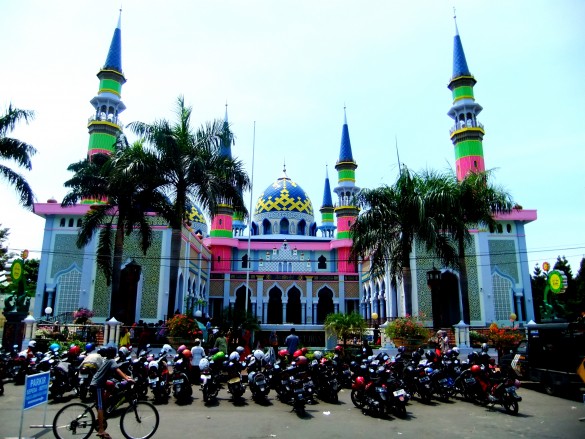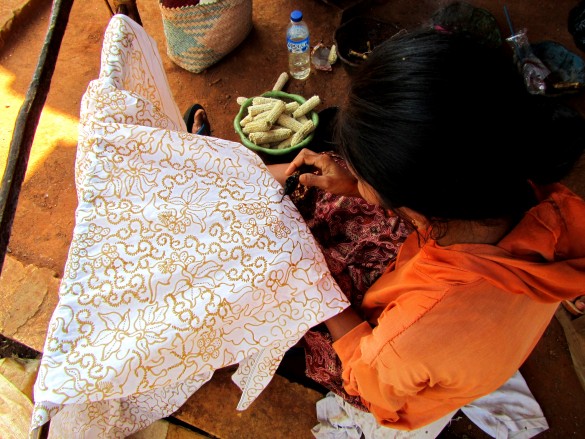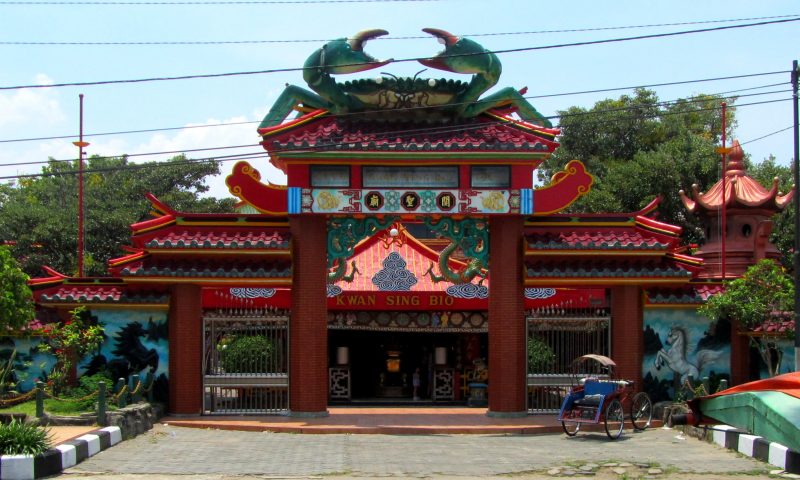Exploring the distinctly Mediterranean town of Tuban on the north coast of East Java, home to an impressive crab temple, an Arab quarter and a striking mosque.
The town of Tuban on the north coast of East Java has a distinctly Mediterranean feel. Is it the seaside location, the use of blue on window sashes, or the laid back feel to the fishing boats nestled in groups lapping against the shoreline which suggests this?
It is no longer quite the sleepy town that guidebooks had it down as being until recently. The region is now home to four cement and two chemical factories, and with the recent discovery of abundant natural gas, it could soon lose its remote backwater reputation. Fortunately, industry is scarcely visible in the town and with its wide-open tree-lined streets, with many houses of the colonial Dutch era, it is perfect for a leisurely stroll. There are few motor vehicles, but plenty of horse-drawn carriages and becak pedicabs.
Established in the 12th century, the town gradually gained a position as a principal seaport along the Pesisiran coastline, known as the Islamic coast, being the entry point for the establishment of Islam in Java, with boats arriving at the shores from the rest of Southeast Asia and even further afield. The history accounts for the abundant Chinese culture to be found here – a hangover of the trade in spices, exchanged for Chinese ceramics. It’s also considered an important Islamic pilgrimage town, being home to the grave of one of the wali or ‘saints’ revered for having introduced and spread Islam throughout Java in the 16th century.
What’s nice about Tuban is the seafront outlook. Unlike Surabaya, which turns its back on the sea, Tuban makes a feature of it. The main road runs along the front and offers a beautiful panorama of the Java Sea. The stretch of road is rich in sights with the Kwan Sing Bio klenteng (temple) the easiest to spot.
Reputed to be the largest Chinese temple in Southeast Asia, it is a fabulously garish place with an enormous crab effigy bearing down over the entrance.
Sightseers are welcome inside and if you’re lucky you’ll catch one of the noisy Punch and Judy-like puppet performances, retelling Confucius-Buddhist epics, spiced with social comment on our times.
Just to the east of this on the alun-alun or town square is the splendid Masjid Agung, also known as Masjid Jami’q. Built in 1894 in Arab style by the Dutch architect Toxepeus, it’s particularly elegant in its symmetry with three pointed domes over two Moresque arches. (Non-Muslims will have to be content with an exterior view.)

Just below the mosque is a small lane that leads to the grave of Sunan Bonang, who died in 1525. In the late 15th century he travelled widely throughout Java preaching the new (for these parts) creed of Islam and at a time when most of Java was Hindu-Buddhist or animist. His tomb, open to visitors, is surrounded by elegant whitewashed walls and archways decorated with Chinese and Dutch ceramics set into the surface. Interestingly, the tomb itself blends Hindu and Islamic architectural styles – the old with the new.
Numerous stalls are set up outside the entrance selling a colourful array of goods to the many pilgrims who make their way here from elsewhere in Indonesia – holy spring water, prayer rugs, prayer recordings, dates from the Middle East and gold embossed Korans. This is a great place to buy local snacks, including Babat Wingko, a coconut pancake. Batik Gedok, unique to the region, is on sale here too as T-shirts, formal shirts, blouses, dresses and sarong lengths. It’s batik made on hand-loomed cotton and very rustic and homespun looking.

A popular sight in the town centre is the Akbar Caves, just behind the Pasar Baru market, and although not the only caves in the region, they are certainly the most accessible. Reaching a depth of over 1,200 metres, the caves vary from huge open spaces to narrow dark tunnels, many not yet fully explored. Bats line the ceilings and a smell of fermented fruit from the droppings is detectable. A small waterfall flows from one corner of the cave interior into a stream carrying a flow of tiny fresh water fish from the cave’s inner depths. Subtly lit with electric lights, the stalactites are often finely shaped with delicate colouring.
If you have time it’s worth venturing onto the region’s other attractions, the Bekitharjo natural swimming baths (6km downtown), the famed Gedok batik cottage industry (25km southwest) and the splendid Nglirip waterfalls (35km west of the city near Bancar beach).
Fast facts: Tuban
Province: East Java
Population: 1.15 million
Area: 1,834.15 km2 (708.17 sq miles)
Getting there: Located just 100km northwest of Surabaya, Tuban is an easy two-hour trip by car along a wide-open road skirting the coastline. Take the Surabaya-Gresik toll road to Manyar, drive onwards past Sidayu and Tanjung Kodok.
Where to stay: Comfortable accommodation can be found at the centrally located Hotel Resor Tuban Tropis, Jl. Basuki Rachmad 3. Tel: (062356) 325800. www.resortuban.com
Alternatively stay at Tanjung Kodok on the way to Tuban: an exotic hotel of apartment-like rooms overlooking the Java Sea.
Tanjung Kodok Beach Resort, Jl. Raya Paciran, Paciran, Kabupaten Lamongan. Tel: (0322) 666000 www.tanjungkodokbeachresort.com
Where to eat: A good local restaurant is Restoran Pangestune on Jl. Raya Semarang 2.




